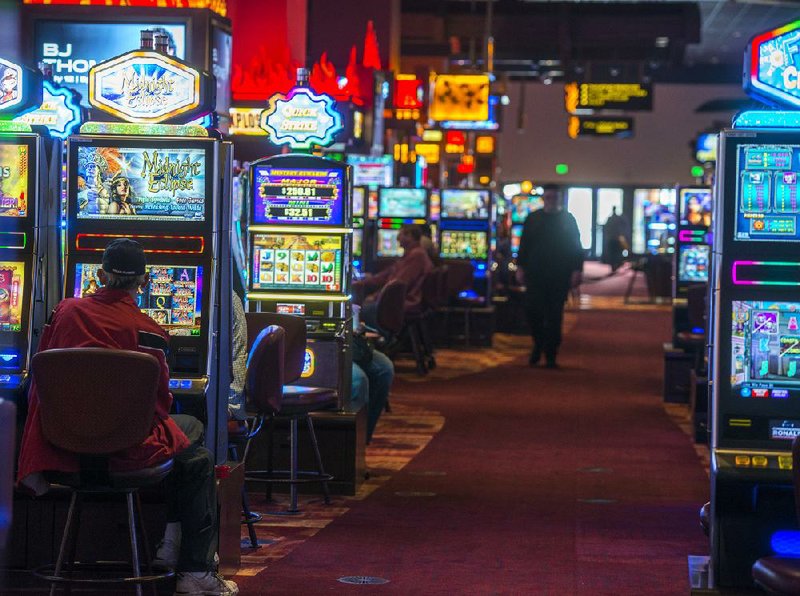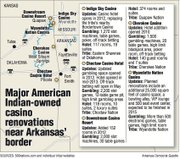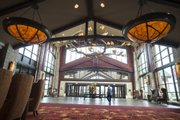Oklahoma saw revenue from its American Indian owned gambling operations increase significantly compared with national trends in 2012, according to an industry report released recently.
Five of Oklahoma’s Indian tribes have large-scale casino operations near the state line with Arkansas. All have upgraded, new or are expanding casino floors and nongambling amenities like hotels, restaurants and spas. Two are close to Fort Smith and Siloam Springs.
Most of the casinos say gamblers from Arkansas and other neighboring states are part of their customer base.
Nationally, revenue for Indian-owned casinos rose 2 percent in 2012 to $28.1 billion, an all-time high. The industry report noted that growth in the segment has slowed compared with 2011, which saw total revenue rise 3.4 percent. Indian casinos are now facing more competition from conventional and racetrack casinos, according to Casino City’s Indian Gaming Industry Report released in late March.
Oklahoma came in seventh nationally in revenue growth among Indian casinos in 28 states, up 6.6 percent to $3.7 billion in 2012, but the growth rate declined slightly from 2011 when the state ranked fourth, with growth of 7.7 percent, the report said. The state ranked second by total revenue behind California, which took in $6.96 billion in 2012. Combined, the two states made up about 38 percent of all Indian gambling revenue in 2012. The report accounts for 468 gambling facilities operated by 243 tribes.
Arkansas does not have any tribal-owned gambling,but betting is allowed on greyhound races at Southland Park in West Memphis and Thoroughbred horse races at Oaklawn Park in Hot Springs. State law allows gambling on electronic devices at the racetracks that are similar to devices offered at out-of-state casinos.
In January, Southland Park officials said they’d spend $37.4 million to expand their facility to accommodate up to 2,000 new games, a restaurant and a sports bar. Southland Park undertook an $11 million expansion in 2012 that added 200 machines. In June, planners in Hot Springs approved an Oaklawn Park expansion to add 500 games to the 1,000 already there. A building permit was issued in November.
While Oklahoma posted revenue growth stronger than national trends, Indian gambling operations overall are suffering from the sluggish economy, which is putting pressure on gamblers, said Alan Meister, an economist with Nathan Associates Inc., which wrote the report.
Still, Oklahoma saw increases in its number of gambling facilities, gambling machines and table games for the period.
In 2012, 33 tribes operated gambling facilities in Oklahoma, unchanged since 2010.However, three new facilities were added in that state, raising the total for the year to 118. Oklahoma added 4,500 gambling machines in 2012, the largest increase in the nation, raising the state’s total by 7.1 percent to 68,134, and taking the No. 1 position from California, which has 67,937 a 0.6 percent decline from the year before.
As far as table games go, Oklahoma saw an 8 percent increase in 2012 to 813, but still came in a distant second to California, which had 1,921 but saw a 3.5 percent decline for the year.
Meister said Oklahoma has the advantage of drawing customers who have limited or no casino-style gambling options in their states, like Arkansas and Texas. He said the casino operations closer to the borders of those two states tend to be of higher quality and are designed to attract travelers with amenities like hotels, golf courses and spas.
BORDER ATTRACTIONS
In 2012 in Wyandotte in northeast Oklahoma, the Eastern Shawnee of Oklahoma opened the Indigo Sky Casino, which includes a hotel. In West Siloam Springs, the Cherokee Nation operates the Cherokee Casino, which was significantly upgraded in 2010.
In Quapaw in northeast Oklahoma, the Quapaw Nation operates the Downstream Casino Resort, which opened a 152-room hotel expansion in late 2012; and just across the state line from Fort Smith, the Choctaw Nation upgraded and expanded the gambling floor at its Pocola casino in 2012 and added a hotel in May 2013.
Anna Lindsay, a spokesman for the Choctaw Casino Hotel in Pocola, said that three-fourths of the casino’s customers and hotel guests are from Arkansas, and about half of its nearly 500 employees commute to work from Arkansas.
She said the hotel and upgraded amenities fill a need in the market. She said the casino is continuing to evolve to meet customer demand. She cited the addition of a craft beer selection at its Trophy’s Bar & Grill and a new moonshine and whiskey menu at its Gilley’s restaurant. The casino also is adding an off-track betting room that’s expected to open in May.
Mark Fulton, chief operating officer for Cherokee Nation Entertainment, said that the tribe’s Cherokee Casino in West Siloam Springs, across the state line from Siloam Springs, is its second biggest and that updates in 2010 - including the addition of a hotel - turned it into a multifaceted entertainment destination rather than a day trip for casino goers.
Nongambling revenue at tribal casinos nationally was up nearly 3 percent to about $3.4 billion in 2012, the second consecutive year for growth. Oklahoma’s tribal casinos saw nongambling revenue rise to $510 million, a 3.4 percent increase when compared with 2011. Nongambling revenue for the state has grown since 2009.
In late 2013, the Wyandotte Nation said it was beginning a $7 million renovation of its casino in the northeast corner of Oklahoma, part of a broader, $30 million master project at the Wyandotte Nation Casino at Wyandotte, Okla.
The first phase includes an expansion of 25,000 square feet, doubling the casino’s current size. The new area will include a club, a VIP lounge, a four-lane bowling alley and an entertainment venue that will seat 500. The casino will remain open during the expansion, which is expected to take a year.
Wyandotte Nation Chief Billy Friend has said that offering entertainment that sets the casino apart is vital. He said the goal is not to expand the gambling operation but to attract customers who are not solely focused on gambling.
LOCATION, LOCATION, LOCATION
The casino report noted that overall revenue growth for American Indian tribes in 2012 was “markedly slower” than other gambling segments. The commercial casino segment grew 4 percent while the racetrack casino segment grew 8 percent. The commercial casino segment made up 45 percent of all gambling revenue in the United States in 2012, with American Indian-owned operations accounting for 43 percent of all revenue, and racetrack casinos generating 12 percent.
Arkansas neighbors Mississippi, Louisiana and Missouri allow commercial casino gambling. The Indian Gaming Industry Report said that in 2012, Mississippi had $2.25 billion in gambling revenue, an increase of half a percentage point; Louisiana had $2 billion, a gain of nearly 1 percent; and Missouri had $1.77 billion, a loss of 2 percent.
In late March, Caesars Entertainment said it would close its Harrah’s casino in Tunica in June and lay off 1,300 workers. The sluggish economy, and competition from Arkansas’ racetrack casinos and casinos in Oklahoma and Missouri were cited as reasons casino revenue has declined at Tunica.
Competition works in favor of the Oklahoma casinos, said Marc Anthony Fusaro, associate professor of economics at the College of Business at Arkansas Tech University at Russellville.
“Competition is limited and different compared with nontribal [gambling],” he said.
He noted that for most of the northwestern and north central part of the state, it’s a shorter drive to the Oklahoma casinos than the two Arkansas racetracks. In Oklahoma, tribes set up casinos only on their own land, so even if there was a desire to directly compete with another casino by opening across the street, geography limits that.
“The limits on tribal [gambling] creates a type of buffer,” Fusaro said.
Location is key, said Sean Harrison, spokesman for Downstream Casino Resort. The casino-hotel in the northeast corner of Oklahoma draws customers in a 150-mile radius that includes Arkansas, Missouri and Kansas. He said about 20 percent of the casino’s customers come from Arkansas, and about 50 percent travel in from southwestern Missouri, because the closest commercial casinos in that state are in Kansas City and St. Louis.
“We had a great location for building Downstream, and I think our success is partly because we are the only resort of this scope and scale in the region,” he said. “It might not work as well if there were two or three of these types of resorts in this market.”
He noted that Downstream has embraced the concept that the casino experience is more than just gambling, and that gives the operation a competitive advantage.
“Like the name indicates, Downstream Casino Resort is a resort. The Quapaw Tribe built this place to offer guests the escape, the wide range of dining and entertainment options, luxury, and the full service to provide the whole resort experience.”
Business, Pages 71 on 04/06/2014


